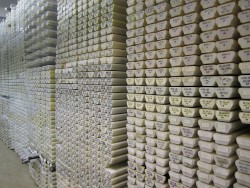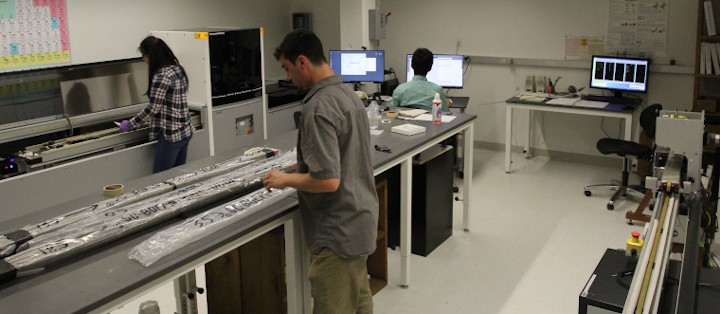Facilities
The Lamont-Doherty Core Repository occupies about 15,000 square feet on the first floor of the Core Laboratory and on the basement level of the Geoscience Building. The space includes a main office and conference room of 560 sq ft., a large space for sampling and permanent exhibits for visitors of 1,058 sq ft, a walk-in refrigerator of 4,666 sq ft., and a coral storage area of 600 sq ft.
Core Storage

We have four large lockers that are used for storage of cores. There are 77 racks in the main dry core storage areas containing a total of 53,880 eight foot long trays. The refrigerated storage in the Core Repository, kept at 40°F, was upgraded in 2019 with a new refrigeration unit and an enlarged footprint giving us room to grow for several more years.
Typically cores entering the repository are prepared by cutting them into 1.5 m (approximately five feet) lengths and then splitting them longitudinally. Intervals are permanently marked with non-corrosive, non-reactive markers every 10 cm in both working and archive halves of the core. The split cores are photographed and described. Lithologic properties of the sediment are logged by interval, including mass properties such as: texture and color; structure such as bedding, burrows; composition including carbonate content; paleontology and mineralogy; and nature of basal contact to next interval. Storage of the majority of the collection is dry, in 8-foot galvanized steel trays. Cores added to the repository after 1985 have been refrigerated, moist, in 5-foot D-tubes. Dredges, many of them described by the project's Principal Investigator, are stored in 1 x 1 x 2 foot wooden crates, and more recently, 8" x 14" x 24" fiber-glass reinforced plastic bins.
Archival Services
Curation and archiving procedures including megascopic descriptions, photographs and MST runs are performed routinely on all cores collected with NSF support that enter the repository. For cores collected without NSF funding, we can provide long-term storage and curation support under the provision that the material be made available to the research community upon completion of the original project. In addition, individual parts of the archival process (i.e., splitting, photography, etc.) can be provided for non-archived cores on a per-project cost basis. Please inquire regarding any procedures not listed as we are willing to work out a system to help you and your project if at all possible.
Archival Fees for FY 22-23
- Full archiving (core splitting, photographing, meta-data/data entry, describing and materials)
- Price per 100cm
- $45.71
- Core splitting and photographing (includes d-tubes)
- Price per 100cm
- $34.14
- Core splitting only (includes d-tubes)
- Price per 100cm
- $25.23
Instrument Labs
The Repository operates a number of labs and instruments dedicated to making fundamental measurements on material entering the repository including several non-destructive methods. Instruments for conducting and/or assisting with analyses of deep-sea sediments include a GeoTek Multi-Sensor Core Logger, an Itrax XRF core scanner, a UIC coulometer, a Micromeritics sedigraph, Vane Shear, Sonic Sifter, core splitter, freeze dryer, as well as a variety of microscopes, sieves, and sampling tools. These instruments are available to the scientific community on a fee basis; see below for current pricing.
For actual sampling of core material, standard tools for sampling wet cores are available. We also have a hand-held high-speed drill fitted with a dental bit for high-resolution sampling of dry cores. The sampling can be done without removing the sediment from the tray that in the past has been a problem for maintaining the integrity of dried sediment. For larger samples we use a scroll saw fitted with a diamond coated musical wire that produces clean cuts with almost no loss of material.

MST/XRF Lab
Our GeoTek multisensor track (#46) includes a gamma-ray attenuation porosity evaluator (GRAPE) and compressional wave (P-wave) logger devices that measure bulk density, porosity, and sonic velocity. It also has two Bartington magnetic susceptibility loops for different sized cores as well as a Bartington point sensor for running on split cores. We can run whole round or split cores, u-channels, etc... This analysis is non-destructive.
The Itrax Corescanner offers rapid, non-destructive analysis of split sediment cores, coral slabs, u-channels... virtually any flat sample up to 180cm long by 12cm wide by 6cm high/thick. It is capable of sample resolutions as high as 60 microns and provides high-resolution digital photography, X-Radiography and XRF elemental analysis for Magnesium through Uranium. Results are qualitative unless it is calibrated with standard reference materials of a similar matrix to your sample.
The Itrax data can be used for inter-core correlations, event stratigraphy (ash layers, turbidites, ice-rafted debris, atomic bomb testing), pollution histories (leaded gasoline, localized contaminants), proxies for paleoclimate research, and help in determining relative grain size (turbidites) and water and organic matter content.
We can run samples for you or train you to run them yourself. Our knowledgeable staff can also assist with data reduction and interpretation if you are not familiar with XRF data and the Itrax software.
In addition, the Sciaps Z-300 Handheld LIBS (Laser Induced Breakdown Spectroscopy) is a handheld elemental analyzer, capable of measuring concentrations of elements from Lithium to Uranium. It is possible to prepare nearly any solid sample (e.g., rock, fossils, plant material) for rapid (<20s), high-resolution (100 μm laser spot size), minimally destructive analysis. It can also generate 1mmx1mm qualitative elemental heat maps across a surface. Results are qualitative unless calibrated with standard reference materials. Most samples do not require special preparation. Instrument is field-portable.
Instrument Fees, Core Scanning, FY 22-23
- Geotek MST - whole or split core
- We Run
- $25.56/meter
- You Run
- $15.05/meter
- Itrax XRF Core Scanner (Contact the Curator for pricing)
- We Run
- You Run
- LIBS
- We Run
- $12.08/sample
- You Run

Sediment Analysis Lab
We have an Olympus BTX-II XRD analyzer that allows for rapid X-Ray Diffraction (mineralogical information) analysis on small amounts (~20mg) of crushed samples (<150 microns) in 30 – 90 minutes. There are two post-processing modes, quantitative, in which you must provide standardized reference materials, and qualitative, which can provide phase identification information from a range of 5 - 55° 2Ø.
We do grain size analysis using a Micromeritics Sedigraph 5100 that allows for grain size measurement below 63 microns (down to 0.8 microns) and an ATM L3P Sonic Sifter for separating the coarse fraction of sediments into multiple size fractions. When used together, we can generate a grain size profile for any sediment sample. A Micromeritics Pycnometer is used to measure dry bulk density on samples under 10cc and we have a UIC CM5012 CO2 Coulometer paired with an AutomateFX sampling carousel that allows us to process almost 100 samples for total inorganic carbon per day.
We also have two automated sample washing stations that each allow for up to eight disaggregated sediment samples to be wet sieved at one time!
Instrument Fees, Sediment Processing, FY 22-23
- X-Ray Diffraction
- We Run (per sample)
- $11.27
- You Run (per sample)
- $6.57
- Carbonate (requestor provides prepared samples)
- We Run (per sample)
- $2.20
- You Run (per sample)
- $1.85
- Fine Fraction size analysis (coarse fraction analysis is charged on an hourly basis)
- We Run (per sample)
- $28.92
- You Run (per sample)
- $16.21
- Sediment Washing
- We Run (per sample)
- $3.97
- You Run (per sample)
- $1.06
For further information contact the Curator, [email protected].

